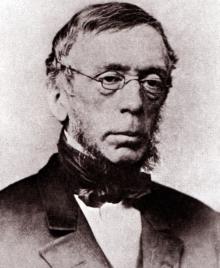- Home
- Archival Material
- College History Projects
- Subject-Based Digital Projects
William Wood Gerhard (1809-1872)

William Wood Gerhard was born on July 23, 1809 to a Moravian Brethren hatter and his wife in Philadelphia. William, the eldest child, was educated at home and in local schools; as a voracious reader he was able to enter Dickinson College with the class of 1826 at the age of seventeen. While at the College, both he and his brother Benjamin were active members of the Union Philosophical Society. He returned to Philadelphia to study medicine under the well known Joseph Parrish and at the University of Pennsylvania Medical School where he was awarded a medical degree in 1830. Both before and after his degree was awarded, he served a residency in the Philadelphia Almshouse and made observations on communicable diseases. When the opportunity arose for him to study in Paris in spring 1831, thanks to an influential professor at Penn, Dr. Samuel Jackson, he was drawn to the teachings of Pierre-Charles-Alexander Louis, the founder of medical statistics for which careful observation, recording and analysis of cases were paramount.
Louis was to have a powerful influence on medicine in the United States through his encouragement of American students, and Gerhard became one of the small group who were to bring that influence to bear. He also visited the medical school at Edinburgh on his way home and observed an outbreak of typhus in that city. He returned to Philadelphia and his residency in 1833, and was able to convince the Almshouse to change its name to the Philadelphia Hospital. His early research centered on diseases in poor children, but by 1837 he had completed his most important discovery, which clearly distinguished for the first time that typhus and typhoid, though they often shared symptoms, were separate and distinct contagions. His ideas and use of scientific statistical tools also represented an historic break with the dominant thinking of Benjamin Rush and his successors as well as the value of the new methods coming from Paris. Gerhard himself had contracted typhoid fever that same year during his work in the Philadelphia poor wards. He was named as professor of the institutes of medicine at the University of Pennsylvania in 1838 and remained in that post until his death. In 1842, his Lectures on the Diagnosis, Pathology, and Treatment of Diseases of the Chest brought him further recognition. He was also the founder and first president of the Pathological Society of Philadelphia.
Never in the best of health after his brush with typhoid, he suffered several small strokes during his career. Observers noticed that his drive and his originality suffered as time went on, although he published an important paper on epidemic cerebral spinal meningitis or "spotted fever" in 1863 and he remained a popular lecturer. In 1850 he had married the daughter of a retired British officer named Dobbyn and the couple had three children. Following a visit to Europe and a meeting with his old mentor, Louis, in 1868, he fractured an ankle and retired from active medical practice. He never completely recovered from this injury and on April 28, 1872 died of a stroke at the age of 62. The William Wood Gerhard Gold Medal, awarded each year since 1925 by the Pathological Society of Philadelphia, successors to the original society he had founded, celebrates his memory.
Date of Post:
2005
College Relationship:
Alumnus/Alumna Class Year: